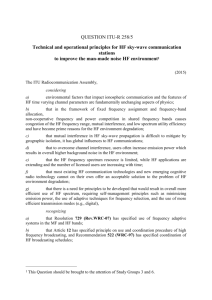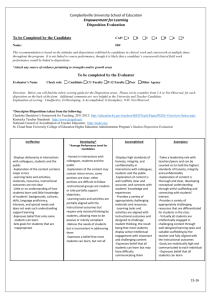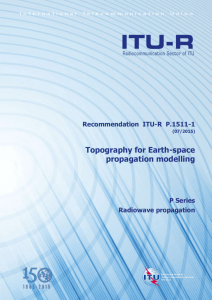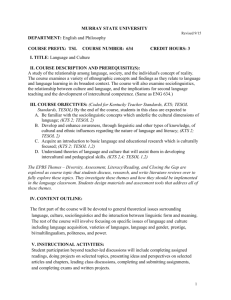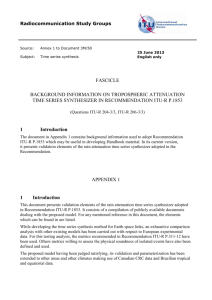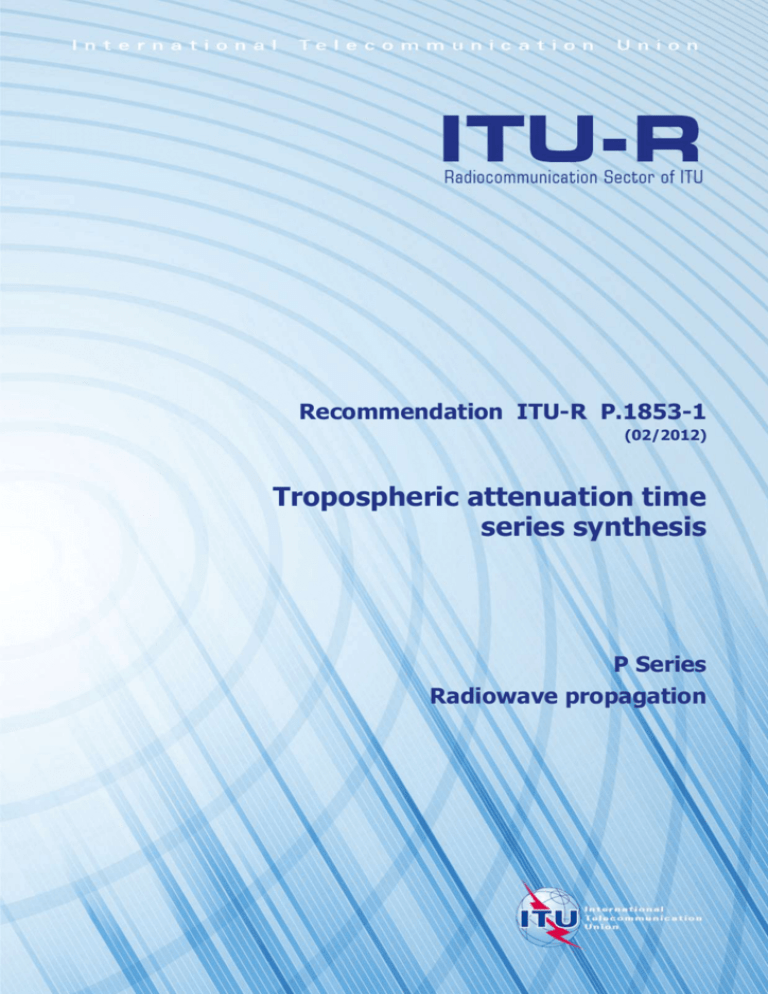
Recommendation ITU-R P.1853-1
(02/2012)
Tropospheric attenuation time
series synthesis
P Series
Radiowave propagation
ii
Rec. ITU-R P.1853-1
Foreword
The role of the Radiocommunication Sector is to ensure the rational, equitable, efficient and economical use of the
radio-frequency spectrum by all radiocommunication services, including satellite services, and carry out studies without
limit of frequency range on the basis of which Recommendations are adopted.
The regulatory and policy functions of the Radiocommunication Sector are performed by World and Regional
Radiocommunication Conferences and Radiocommunication Assemblies supported by Study Groups.
Policy on Intellectual Property Right (IPR)
ITU-R policy on IPR is described in the Common Patent Policy for ITU-T/ITU-R/ISO/IEC referenced in Annex 1 of
Resolution ITU-R 1. Forms to be used for the submission of patent statements and licensing declarations by patent
holders are available from http://www.itu.int/ITU-R/go/patents/en where the Guidelines for Implementation of the
Common Patent Policy for ITU-T/ITU-R/ISO/IEC and the ITU-R patent information database can also be found.
Series of ITU-R Recommendations
(Also available online at http://www.itu.int/publ/R-REC/en)
Series
BO
BR
BS
BT
F
M
P
RA
RS
S
SA
SF
SM
SNG
TF
V
Title
Satellite delivery
Recording for production, archival and play-out; film for television
Broadcasting service (sound)
Broadcasting service (television)
Fixed service
Mobile, radiodetermination, amateur and related satellite services
Radiowave propagation
Radio astronomy
Remote sensing systems
Fixed-satellite service
Space applications and meteorology
Frequency sharing and coordination between fixed-satellite and fixed service systems
Spectrum management
Satellite news gathering
Time signals and frequency standards emissions
Vocabulary and related subjects
Note: This ITU-R Recommendation was approved in English under the procedure detailed in Resolution ITU-R 1.
Electronic Publication
Geneva, 2013
ITU 2013
All rights reserved. No part of this publication may be reproduced, by any means whatsoever, without written permission of ITU.
Rec. ITU-R P.1853-1
1
RECOMMENDATION ITU-R P.1853-1
Tropospheric attenuation time series synthesis
(2009-2011)
Scope
This Recommendation provides methods to synthesize rain attenuation and scintillation for terrestrial and
Earth-space paths and total attenuation and tropospheric scintillation for Earth-space paths.
The ITU Radiocommunication Assembly,
considering
a)
that for the proper planning of terrestrial and Earth-space systems it is necessary to have
appropriate methods to simulate the time dynamics of the propagation channel;
b)
that methods have been developed to simulate the time dynamics of the propagation
channel with sufficient accuracy,
recommends
1
that the method given in Annex 1 should be used to synthesize the time series of rain
attenuation for terrestrial or Earth-space paths;
2
that the method given in Annex 1 should be used to synthesize the time series of
scintillation for terrestrial or Earth-space paths;
3
that the method given in Annex 1 should be used to synthesize the time series of total
tropospheric attenuation and tropospheric scintillation for Earth-space paths.
Annex 1
1
Introduction
The planning and design of terrestrial and Earth-space radiocommunication systems requires the
ability to synthesize the time dynamics of the propagation channel. For example, this information
may be required to design various fade mitigation techniques such as, inter alia, adaptive coding
and modulation, and transmit power control.
The methodology presented in this Annex provides a technique to synthesize rain attenuation and
scintillation time series for terrestrial and Earth-space paths and total attenuation and tropospheric
scintillation for Earth-space paths that approximate the rain attenuation statistics at a particular
location.
2
Rec. ITU-R P.1853-1
2
Rain attenuation time series synthesis method
2.1
Overview
The time series synthesis method assumes that the long-term statistics of rain attenuation is
a log-normal distribution. While the ITU-R rain attenuation prediction methods in Recommendation
ITU-R P.530 for terrestrial paths and Recommendation ITU-R P.618 for Earth-space paths are not
exactly log-normal, these rain attenuation distributions are well-approximated by a log-normal
distribution over the most significant range of exceedance probabilities. The terrestrial and
Earth-space rain attenuation prediction methods predict non-zero rain attenuation for exceedance
probabilities greater than the probability of rain; however, the time series synthesis method adjusts
the attenuation time series so the rain attenuation corresponding to exceedance probabilities greater
than the probability of rain is 0 dB.
For terrestrial paths, the time series synthesis method is valid for frequencies between 4 GHz and
40 GHz and path lengths between 2 km and 60 km.
For Earth-space paths, the time series synthesis method is valid for frequencies between 4 GHz and
55 GHz and elevation angles between 5º and 90º.
The time series synthesis method generates a time series that reproduces the spectral characteristics,
fade slope and fade duration statistics of rain attenuation events. Interfade duration statistics are also
reproduced but only within individual attenuation events.
As shown in Fig. 1, the rain attenuation time series, A(t), is synthesized from the discrete white
Gaussian noise process, n(t). The white Gaussian noise is low-pass filtered, transformed from
a normal distribution to a log-normal distribution in a memoryless non-linearity, and calibrated to
match the desired rain attenuation statistics.
FIGURE 1
Block diagram of the rain attenuation time series synthesizer
Low-pass filter
n(t)
White
gaussian noise
k
p +b
Memoryless non-linear device
X( t)
exp( m +
´ X (t ))
Calibration
A( t)
Aoffset
Rain attenuation (dB)
The time series synthesizer is defined by five parameters:
m: mean of the log-normal rain attenuation distribution
:
p:
standard deviation of the log-normal rain attenuation distribution
probability of rain
b:
parameter that describes the time dynamics (s–1)
offset that adjusts the time series to match the probability of rain (dB)
Aoffset:
2.2
Step-by-step method
The following step-by-step method is used to synthesize the attenuation time series Arain(kTs),
k = 1, 2, 3, ...., where Ts is the time interval between samples, and k is the index of each sample.
Rec. ITU-R P.1853-1
A
3
Estimation of m and
The parameters m and are determined from the cumulative distribution of rain attenuation vs.
probability of occurrence. Rain attenuation statistics can be determined from local measured data,
or, in the absence of measured data, the rain attenuation prediction methods in Recommendation
ITU-R P.530 for terrestrial paths and Recommendation ITU-R P.618 for Earth-space paths can be
used.
For the path and frequency of interest, perform a log-normal fit of rain attenuation vs. probability of
occurrence as follows:
Step A1: Determine Prain (% of time), the probability of rain on the path. Prain can be well
approximated as P0(Lat,Lon) derived in Recommendation ITU-R P.837.
Step A2: Construct the set of pairs [Pi, Ai] where Pi (% of time) is the probability the attenuation
Ai(dB) is exceeded where Pi Prain. The specific values of Pi should consider the probability range
of interest; however, a suggested set of time percentages is 0.01, 0.02, 0.03, 0.05, 0.1, 0.2, 0.3, 0.5,
1, 2, 3, 5, and 10%, with the constraint that Pi Prain.
P
Step A3: Transform the set of pairs [Pi, Ai] to Q 1 i , ln Ai ,
100
where:
Q x
Step A4: Determine the variables
mln Ai
1
2
e
t2
2 dt
(1)
x
and ln Ai by performing a least-squares fit to
P
ln Ai σ ln Ai Q 1 i mln Ai for all i. The least-squares fit can be determined using the
100
“Step-by-step procedure to approximate a complementary cumulative distribution by a log-normal
complementary cumulative distribution” described in Recommendation ITU-R P.1057.
B
Low-pass filter parameter
Step B1: The parameter b = 2 ´ 10–4 (s–1).
C
Attenuation offset
Step C1: The attenuation offset, Aoffset (dB), is computed as:
Aoffset
D
P rain
m Q 1
100
e
(2)
Time series synthesis
The time series, Arain(kTs), k = 1, 2, 3, ... is synthesized as follows:
Step D1: Synthesize a white Gaussian noise time series, n(kTs), where k = 1, 2, 3, ... with zero mean
and unit variance at a sampling period, Ts, of 1 s.
Step D2: Set X(0) = 0
Step D3: Filter the noise time series, n(kTs), with a recursive low-pass filter defined by:
X kTs ´ X k 1Ts 1 2 ´ nkTs
for k = 1, 2, 3, ....
(3)
4
Rec. ITU-R P.1853-1
ebTs
where:
(4)
Step D4: Compute Yrain(kTs), for k = 1, 2, 3, ... as follows:
Yrain kTs em X kTs
(5)
Step D5: Compute Arain(kTs) (dB), for k = 1, 2, 3, ... as follows:
Arain kTs Maximum Y kTs Aoffset ,0
(6)
Step D6: Discard the first 200 000 samples from the synthesized time series (corresponding to the
filter transient). Rain attenuation events are represented by sequences whose values are above 0 dB
for a consecutive number of samples.
3
Scintillation time series synthesis method
As shown in Fig. 2, a scintillation time series, sci t , can be generated by filtering white Gaussian
noise, n(t), such that the asymptotic power spectrum of the filtered time series has an f–8/3 roll-off
and a cut-off frequency, fc, of 0.1 Hz. Note that the standard deviation of the scintillation increases
as the rain attenuation increases.
FIGURE 2
Block diagram of the scintillation time series synthesizer
n(t)
White
gaussian noise
Magnitude (dB)
Low-pass filter
–80/3 dB/decade
sci( t)
Scintillation (dB)
¦c
Frequency
4
Integrated cloud liquid water content time series synthesis method
4.1
Overview
As it is suggested in Recommendation ITU-R P.840, the time series synthesis method approximates
the statistics of the long-term integrated liquid water content (ILWC) by a log-normal distribution.
The time series synthesis method generates a time series that reproduces the spectral characteristics,
rate of change and duration statistics of cloud liquid content events.
As shown in Fig. 3, the liquid content time series, L(t), is synthesized from the discrete white
Gaussian noise process, n(t). The white Gaussian noise is low-pass filtered, truncated to match the
desired cloud probability of occurrence, and transformed from a truncated normal distribution to a
conditioned log-normal distribution in a memoryless non-linearity.
Rec. ITU-R P.1853-1
5
FIGURE 3
Block diagram of the cloud ILWC time series synthesizer
Low-pass filter
n( t)
White
gaussian noise
Calibration
k
k
g1 1 + g2 2
p + b1
p + b2
Gc( t)
a(PCLW)
Memoryless non-linear device
exp Q-1
1
PCLW
L( t)
Q( GC( t)) ´ + m
Correlated
gaussian process
Cloud liquid
water content (mm)
The time series synthesizer is defined by eight parameters:
m: mean of the log-normal rain attenuation distribution
:
PCLW:
4.2
standard deviation of the log-normal rain attenuation distribution
probability of clouds
a:
truncation threshold of the correlated Gaussian noise
b1:
parameter that describes the time dynamics of the process fast component (s–1)
b2:
parameter that describes the time dynamics of the process slow component (s–1)
g1:
parameter that describes the weight of the process fast component
g2:
parameter that describes the weight of the process slow component
Step-by-step method
The following step-by-step method is used to synthesize the cloud liquid water content time series
L(kTs), k = 1, 2, 3, ...., where Ts is the time interval between samples, and k is the index of each
sample.
A
Estimation of m, and PCLW
The mean, m, standard deviation, , and probability of liquid water, PCLW, parameters of the
log-normal distribution are available in the form of maps from Recommendation ITU-R P.840.
For the location of interest, determine the conditional log-normal parameters as follows:
Step A1: Determine the parameters, m1, m2, m3, m4, 1, 2, 3, 4, PCLW1, PCLW2, PCLW3 and PCLW4 at
the four closest grid points of the digital maps provided in Recommendation ITU-R P.840.
Step A2: determine the m, and PCLW parameters value at the desired location by performing
a bi-linear interpolation of the four values of each parameter at the four grid points as described in
Recommendation ITU-R P.1144.
B
Low-pass filter parameters
Step B1: The parameter b1 = 7.17 ´ 10–4 (s–1).
Step B2: The parameter b2 = 2.01 ´ 10–5 (s–1).
Step B3: The parameter g1 = 0.349.
Step B4: The parameter g2 = 0.830.
6
C
Rec. ITU-R P.1853-1
Truncation threshold
Step C1: The truncation threshold a is computed as:
a Q 1 PCLW
(7)
where the Q function is defined in § 2.2.A and documented in Recommendation ITU-R P.1057.
D
Time series synthesis
The time series, L(kTs), k = 1, 2, 3, ... is synthesized as follows:
Step D1: Synthesize a white Gaussian noise time series, n(kTs), where k = 1, 2, 3, ... with zero mean
and unit variance at a sampling period, Ts, of 1 s.
Step D2: Set X1(0) = 0; X2(0) = 0
Step D3: Filter the noise time series, n(kTs), with two recursive low-pass filters defined by:
X kT ´ X k 1T 1 2 ´ nkT
1
1
s
1
s
1 s
2
X 2 kTs 2 ´ X 2 k 1Ts 1 2 ´ nkTs
for k = 1, 2, 3, ....
b T
1 e 1 s
b 2Ts
2 e
where:
(8)
(9)
Step D4: Compute Gc(kTs), for k = 1, 2, 3, ... as follows:
G C kTs g1 ´ X 1 kTs g 2 ´ X 2 kTs
(10)
Step D5: Compute L(kTs) (dB), for k = 1, 2, 3, ... as follows:
1 1
Q GC ( kTs ) ´ m for
exp Q
LkTs
PCLW
for
0
GC ( kTs ) a
GC (kTs ) a
(11)
Step D6: Discard the first 500 000 samples from the synthesized time series (corresponding to the
filter transient). Cloud events are represented by sequences whose values are above 0 mm for a
consecutive number of samples.
5
Integrated water vapour content time series synthesis method
5.1
Overview
The time series synthesis method assumes that the long-term statistics of integrated water vapour
content (IWVC) is a Weibull distribution. While the ITU-R IWVC distributions predicted in
Recommendation ITU-R P.836 are not exactly Weibull, these IWVC distributions are wellapproximated by a Weibull distribution over the most significant range of exceedance probabilities.
Rec. ITU-R P.1853-1
7
The time series synthesis method generates a time series that reproduces the spectral characteristics
and the distribution of water vapour content.
As shown in Fig. 4, the water vapour content time series, V(t), is synthesized from the discrete
white Gaussian noise process, n(t). The white Gaussian noise is low-pass filtered and transformed
from a normal distribution to a Weibull distribution in a memoryless non-linearity.
FIGURE 4
Block diagram of the integrated water vapour content time series synthesizer
Low-pass filter
n(t)
White
gaussian noise
k
Memoryless non-linear device
Gv( t)
p + bv
l–log[Q(Gv(t))])
Correlated
gaussian process
1/k
V(t)
Water vapour
content (mm)
The time series synthesizer is defined by three parameters:
k:
parameter of the Weibull IWVC distribution
l:
parameter of the Weibull IWVC distribution
bV:
5.2
parameter that describes the time dynamics (s–1)
Step-by-step method
The following step-by-step method is used to synthesize the IWVC time series V(kTs),
k = 1, 2, 3, ...., where Ts is the time interval between samples, and k is the index of each sample.
A
Estimation of k and l
The parameters k and l are determined from the cumulative distribution of IWVC vs. probability of
occurrence. IWVC statistics can be determined from local measured data, or, in the absence of
measured data, the IWVC prediction methods in Recommendation ITU-R P.836 can be used.
For the location of interest, perform a Weibull fit of IWVC vs. probability of occurrence as follows:
Step A1: Construct the set of pairs [Pi, Vi] where Pi (% of time) is the probability the IWVC Vi(mm)
is exceeded. The specific values of Pi should consider the probability range of interest; however,
a suggested set of time percentages is 0.1, 0.2, 0.3, 0.5, 1, 2, 3, 5, 10, 20, 30 and 50%.
Step A2: Transform the set of pairs [Pi, Vi] to ln ln Pi , ln Vi .
Step A3: Determine the intermediate variables a and b by performing a least squares fit to the linear
function:
ln ln Pi a ln Vi b
(12)
8
Rec. ITU-R P.1853-1
as follows:
n
n
n
n ln Vi ln ln Pi ln Vi ln ln Pi
i 1
i 1
i 1
2
a
n
n
n ln Vi 2 ln Vi
i 1
i 1
n
n
ln
ln
P
a
ln Vi
i
i 1
i 1
b
n
(13)
Step A4: Determine parameters k and l as follows:
k a
b
l exp a
B
(14)
Low-pass filter parameter
Step B1: The parameter bV = 3.24 ´ 10–6 (s–1).
C
Time series synthesis
The time series, V(kTs), k = 1, 2, 3, ... is synthesized as follows:
Step C1: Synthesize a white Gaussian noise time series, n(kTs), where k = 1, 2, 3, ... with zero mean
and unit variance at a sampling period, Ts, of 1 s.
Step C2: Set GV(0) = 0
Step C3: Filter the noise time series, n(kTs), with a recursive low-pass filter defined by:
GV kTs ´ GV k 1Ts 1 2 ´ nkTs
for k = 1, 2, 3, ....
ebV Ts
where:
(15)
(16)
Step C4: Compute V(kTs), for k = 1, 2, 3, ... as follows:
V kTs l log QGV (kTs ) 1 / k
(17)
where the Q function is defined in § 2.2.A and documented in Recommendation ITU-R P.1057.
Step C5: Discard the first 5 000 000 samples from the synthesized time series (corresponding to the
filter transient).
6
Total attenuation and scintillation time series synthesis method for Earth-space paths
6.1
Overview
Total attenuation and scintillation time series are generated using the scheme illustrated on Fig. 5
and making use of the methods described in the above sections. An appropriate correlation between
clouds and rain has been introduced. This correlation coefficient together with the fact that the
Rec. ITU-R P.1853-1
9
probability to have clouds on the link is higher than the probability to have rain guaranties that
clouds are always generated during rain events.
Cloud liquid water content is interpolated if the two following criteria are simultaneously verified:
–
a rain event is generated (synthetic rain attenuation is greater than 0 dB);
–
ILWC exceeds the 1 mm threshold.
Due to the very low dynamic parameter value for the IWVC component, the first 5.106 samples
have to be discarded from the synthesized time series for all the considered effects (corresponding
to the IWVC filter transient).
For Earth-space paths, the time series synthesis method is valid for frequencies between 4 GHz and
55 GHz and elevation angles between 5º and 90º. For some circumstances (e.g. low frequencies,
moderate to high elevations, temperate areas), the total attenuation may be approximated by the rain
attenuation with sufficient accuracy.
The time series synthesis method generates a time series that reproduces the spectral characteristics,
fade slope and fade duration statistics of total attenuation events. Interfade duration statistics are
also reproduced but only within individual attenuation events.
FIGURE 5
Block diagram of the total attenuation and scintillation time series synthesizer
Rain attenuation
time-series
AR ( t)
nR (t)
Rain attenuation time series synthesis
White
gaussian noise
C RC
n L0 (t)
White
gaussian noise
1– C 2RC
Cloud attenuation
time-series
ILWC
nL (t)
L (t)
´
Cloud ILWC time series synthesis
KL( t)
sin( E)
ITU-R P.840
C CV
nV0 (t)
White
gaussian noise
AC (t)
1–C 2C V
nV ( t)
IWVC
Water vapor attenuation
time-series
V(t)
A V (t)
IWVC time series synthesis
F(V( t),ƒ, E)
ITU-R P.676
-1
Gam 1–exp –
ITU-R P.618
Normalized scintillation
time series synthesis
V(t)
l
k
, 10,
1
10
Fade / enhanc.
correction factor
ITU-R P.1510
Tm
F( T, ƒ, E )
ITU-R P.676
Oxygen attenuation
time-series
Total attenuation
time-series
A (t )
10
6.2
Rec. ITU-R P.1853-1
Step-by-step method
The following step-by-step method is used to synthesize the attenuation time series A(kTs),
k = 1, 2, 3, ...., where Ts is the time interval between samples, and k is the index of each sample.
A
Correlation coefficients
Step A1: The parameter CRC = 1.
Step A2: The parameter CCV = 0.8.
B
Scintillation polynomials
Step B1: define the scintillation fading and enhancement polynomials as:
a Fade ( P) 0.061 ´ log 10 ( P) 0.072 ´ log 10 ( P) 1.71 ´ log 10 ( P) 3.0
3
2
a Enhanc ( P) 0.0597 ´ log 10 ( P) 0.0835 ´ log 10 ( P) 1.258 ´ log 10 ( P) 2.672
3
C
2
(18)
Time series synthesis
The time series, A(kTs), k = 1, 2, 3, ... is synthesized as follows:
Step C1: Synthesize a white Gaussian noise time series, nR(kTs), where k = 1, 2, 3, ... with zero
mean and unit variance at a sampling period, Ts, of 1 s.
Step C2: Synthesize a white Gaussian noise time series, nL0(kTs), where k = 1, 2, 3, ... with zero
mean and unit variance at a sampling period, Ts, of 1 s.
Step C3: Synthesize a white Gaussian noise time series, nV0(kTs), where k = 1, 2, 3, ... with zero
mean and unit variance at a sampling period, Ts, of 1 s.
Step C4: Synthesize a white Gaussian noise time series, nL(kTs), where k = 1, 2, 3, ... as follows:
2
nL kTs CRC ´ nR kTs 1 CRC
´ nL0 kTs
(19)
Step C5: Synthesize a white Gaussian noise time series, nV(kTs), where k = 1, 2, 3, ... as follows:
2
nV kTs CCV ´ nL kTs 1 CCV
´ nV 0 kTs
(20)
Step C6: Compute the rain attenuation time series A(kTs) starting from the Gaussian noise time
series, nR(kTs), following the procedure recommended in § 2 of this Recommendation and replace
step D6 of § 2 by the following: discard the first 5 000 000 samples from the synthesized time
series.
Step C7: Compute the cloud integrated liquid water content time series L(kTs) starting from the
Gaussian noise time series, nL(kTs), following the procedure recommended in § 4 of this
Recommendation and replace step D6 of § 4 by the following: discard the first 5 000 000 samples
from the synthesized time series.
Step C8: Convert the cloud integrated liquid water content time series L(kTs) into cloud attenuation
time series AC(kTs) following the method recommended in Recommendation ITU-R P.840.
Rec. ITU-R P.1853-1
11
Step C9: Identify time stamps k1Ts, k2Ts, k3Ts, … where the two following conditions are
simultaneously verified:
1 – AR(kTs) > 0
2 – L(kTs) > 1
(21)
Step C10: Discard the computed values of AC(kTs) corresponding to the time stamps k1Ts, k2Ts,
k3Ts, … identified at Step C8 and compute instead AC(kTs) for these time stamps based on a linear
interpolation vs. time starting from the non-discarded cloud attenuations values.
Step C11: Compute the integrated water vapour content time series V(kTs) starting from the
Gaussian noise time series, nV(kTs), following the procedure recommended in § 5 of this
Recommendation.
Step C12: Convert the integrated water vapour content time series V(kTs) into water vapour
attenuation time series AV(kTs) following the approximate estimation of slant path water vapour
attenuation method recommended in Recommendation ITU-R P.676 (Annex 2 Section 2.3).
Step C13: Compute the mean annual temperature Tm for the location of interest using experimental
values if available. Else, the method provided in Recommendation ITU-R P.1510 can be used to
predict Tm.
Step C14: Convert the mean annual temperature Tm into mean annual oxygen attenuation AO
following the method recommended in Recommendation ITU-R P.676.
Step C15: Synthesize unit variance scintillation time series Sci0(kTs) following the method
recommended in § 3 of this Recommendation.
Step C16: Compute the correction coefficient time series Cx(kTs) in order to distinguish between
scintillation fades and enhancements:
a Fade 100 ´ Q[ Sci0 ( K .Ts)]
for Sci0 ( K .Ts) 0
C x (k .Ts) a Enhanc 100 ´ Q[ Sci0 ( K .Ts)]
1
for Sci0 ( K .Ts) 0
(22)
where the Q function is defined in § 2.2.A and documented in Recommendation ITU-R P.1057.
Step C17: Transform the integrated water vapour content time series V(kTs) into the Gamma
distributed time series Z(kTs) as follows:
V ( k .Ts) k
,10, 1
Z (k .Ts) Gam 1 exp
l 10
1
(23)
where k and l are the integrated water vapour content Weibull distribution parameters, and the
function Gam is the Gamma complementary distribution function documented in Recommendation
ITU-R P.1057 and defined as:
k 1
Gamx, k ,
x
x
exp x
dt
k k
(24)
12
Rec. ITU-R P.1853-1
Step C18: Compute the scintillation standard deviation following the method recommended in
Recommendation ITU-R P.618.
Step C19: Compute the scintillation time series Sci(kTs) as follows:
5
´
Sci
kT
´
C
(
k
.
Ts
)
´
Z
kT
´
A
kT
12
0
s
x
s
R
s
Sci kTs
´ Sci0 kTs ´C x (k .Ts) ´ Z kTs
for
for
AR kTs 1
AR kTs 1
(25)
Step C20: Compute total tropospheric attenuation time series A(kTs) as follows:
AkTs AR kTs AC kTs AV kTs AO Sci kTs
(26)

